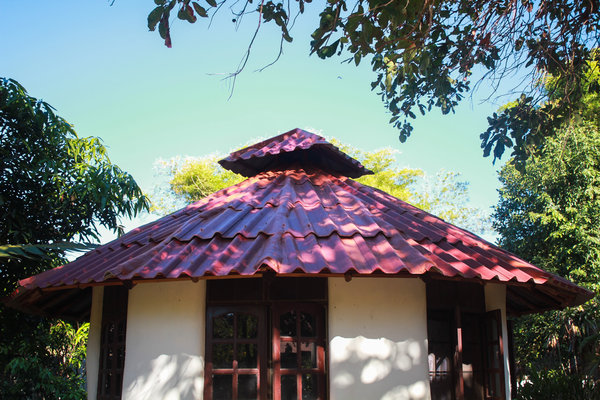
After about three years of life on our vetiver thatch roof we recently replaced the thatch with micro-concrete roofing tiles (MCR). MCR tiles and metal roofing are fast and easy to install, and both work well for roofwater harvesting. I like MCR tiles because they’re more durable and look better than most metal roofing, and don’t get as noisy in rainstorms. We cut the tiles with a right angle grinder and then covered the joints with cement. This roof should last 25 years or more. Also note, the vents on top will provide even better ventilation. (They’re screened to keep birds out.)
You can buy simple machines to make your own MCR tiles, although quality factory made brands are much more durable. We used the same type of roofing tiles on our recycled house on our homestead. Here’s what the original thatched roof looked like. (Beautiful but not very durable.)

what about metal roof? to hot and noisy? what if metal is insulated?
are you a proponent of high roofs or attics (with plastered & insulated) ceilings for hot and humid climates? I dint get a clear answer in your book.
Metal roofs are my standard recommendation because they’re affordable and easy to build. One modern option is adhesive backed foil/foam insulation for the bottom.
Slope and height of roof depends on many factors such as climate. Our ceiling is high because it’s hot here. Plastered ceilings are awkward, and hard to repair if the roof leaks.
My book focuses on earthbag building and so details like this aren’t included.
ok. thanks for reply.
I watched your “Finished Earthbag Roundhouse” video again. so, just to clarify things:your toilet inside the round house has high walls, but no separate ceiling? Right?
so if the roundhouse were large enough to have separate rooms, they would all be like that–walls but no ceiling? I’ve been to a building like that in Malaysia—but walls and the roof were so high you didn’t see or hear anything ( when it comes to a toilet). I think bedrooms had some kind of a wooden ceiling.
There are lots of ways of doing things. In our little guesthouse the low fired brick bathroom walls are about 8′ high for privacy. There’s no ceiling in the bathroom so air can circulate better. I also like attaching the bathroom to the outside of the house (outside bathroom).
what about the pricetag?
I think it was about $1,500 for the new roof. Not sure because we never added everything up. Update: the tricky joints were mortared with cement which are now cracking and leaking due to bad workmanship. We had two sets of workers and both botched the job.
Appreciating the time and energy you put into your blog and detailed information you offer. It’s awesome to come across a blog every once in a while that isn’t the same unwanted rehashed material. Great read! I’ve saved your site and I’m including your RSS feeds to my Google account.
This new roof looks beautiful and it has increased the beauty of the whole place as well. The roofing contractors must have worked very hard to finish this job properly because installing tiles on a roundhouse this neatly can be challenging.
How much did you pay for each one?
I can’t remember. Maybe $2 each.
These look great! How much do they weigh and what dimensions are they? Do you have more information on the structure underneath and cost?
They’re 4mm x 50cm x 120cm (about 5/32″ x 20″ x 47″). Sizes will probably vary from country to country. They’re extremely popular in parts of Asia and probably elsewhere as well because they’re so practical. Metal rusts out too fast and overheats in our tropical climate, clay tile is too expensive and breaks too easily, cement tile is expensive and too heavy so most everyone uses MCR tiles. The big building supply centers have an area about the size of a football field devoted to MCR tiles. Builders love them because they’re very light (just over 1/8″ thick) and fast to install. You can do a roof in 1-2 days with 3 roofers. We put recycled 25-year-old MCR tiles on our pump house and expect them to last another 10 years or maybe even 20. The new brands are stronger with embedded mesh or fibers, but time will tell how long they last. In general, you rarely see MCR problems other than the color fading. Only an occasional leak that’s easy to caulk with silicone.
We added 2x4s on top of our pole frame roof to create a flat, broader surface that’s easy to screw into. The only downside is the view of the roof from inside is way less attractive than the thatch. It’s boring gray cement. Most people would want to add a ceiling or at least some reed or bamboo mat.
A more practical and maintenance free way to go..but doesn’t look as natural..
Does this type of roof get too hot? Or radiate heat inside?
Yes, it’s not as ‘earthy’ looking. But the thatch in our area only lasts 3 years or so and it’s sort of a nuisance to keep replacing. Most modern natural buildings (strawbale, earthbag, adobe, etc.) use metal roofing, so our choice of MCR tiles falls within the norm of what other natural builders are doing. More heat will penetrate, but this shouldn’t be an issue with the steep roof and roof vent.
Hot air could escape through the thatch, but it would have built up under MCR tiles, so we added the roof vent.